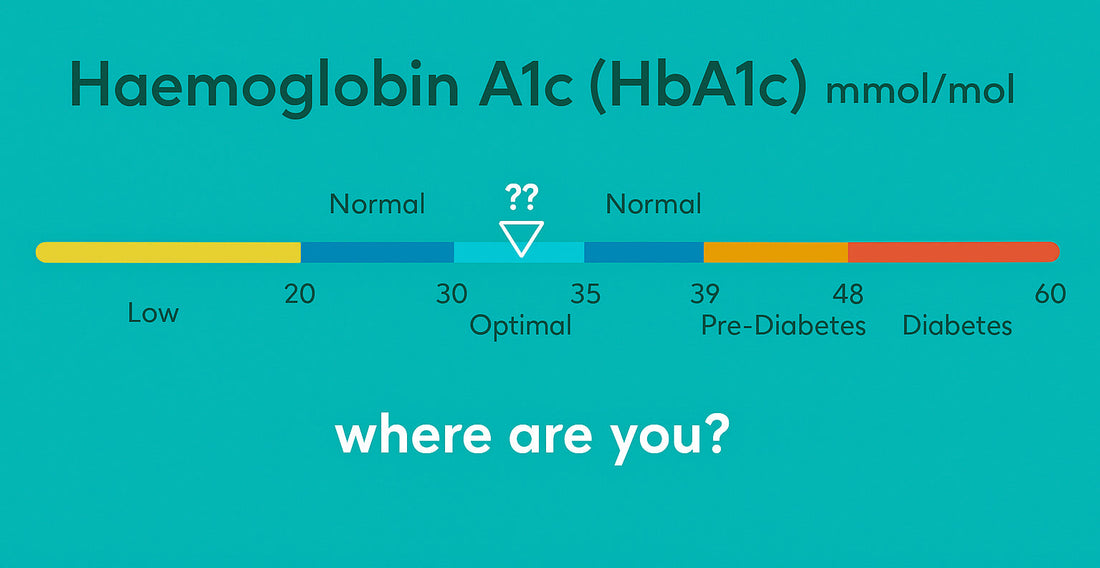
Why We Test HbA1c: Because Metabolic Drift Doesn’t Announce Itself
By Bryce WyldeHe may not have diabetes but that doesn’t mean his blood sugar isn’t damaging his body. For men over 40, one of the most "under the radar" drivers of fatigue, brain fog, belly fat, and hormone decline is insulin resistance and the best early warning system we have is HbA1c.
That’s why HUSBAND includes HbA1c in our test panel. It’s more than just a number, it’s a time machine showing you how his body has handled sugar over the last 3 months.
What Is HbA1c?
HbA1c (short for Hemoglobin A1c) is a blood marker that shows the average level of glucose stuck to red blood cells over a 2–3 month period. Unlike a one-time fasting glucose reading, HbA1c gives you a longer-term, more reliable snapshot of how his body manages blood sugar day after day.
Higher HbA1c means more sugar circulating in the bloodstream and sticking to tissues—which damages blood vessels, hormones, mitochondria, and the brain.
| This isn’t about being diabetic—it’s about not heading that way silently. |
What It Means for Men Over 40
Even without a diabetes diagnosis, men in midlife are especially vulnerable to insulin resistance. It creeps up as metabolism slows, cortisol rises, and testosterone declines.
Elevated HbA1c is associated with:
-
Fat storage around the midsection
-
Poor energy and mental sharpness
-
Low testosterone and high estrogen
-
Cardiovascular risk
-
Accelerated brain aging and memory decline
Most men don’t know they’re heading into prediabetic territory—because the symptoms get blamed on “stress,” “work,” or “just getting older.”
What the Research Says
-
Men with an HbA1c of 5.7% or higher are at significantly increased risk of developing type 2 diabetes, even if fasting glucose is normal.
-
Elevated HbA1c is linked to lower testosterone levels and higher estrogen due to insulin resistance.
-
Studies show that optimizing HbA1c improves not just weight and energy—but mood, libido, and longevity.
It’s not about being “sick.” It’s about catching dysfunction before it turns into diagnosis.
Why It’s in Every HUSBAND Kit
HUSBAND includes HbA1c because metabolic drift doesn’t announce itself. It happens quietly and shows up as stubborn fat, low energy, and flat mood. By measuring it, we can reverse course before it becomes a chronic condition.
Testing HbA1c gives us:
-
A longer-term view of metabolic health
-
Clues to testosterone and insulin sensitivity
-
A foundation for better performance, sleep, and longevity
-
A way to personalize lifestyle and supplement choices
| You can’t fix what you don’t track—and HbA1c tells the truth about how he’s actually doing. |
What Happens If It’s High?
We don’t lecture. We get to work.
-
Recommend time-restricted eating and low-glycemic food swaps
-
Introduce movement and muscle-building strategies that lower blood sugar
-
Use ingredients like berberine, cinnamon extract, magnesium, and myo-inositol
-
Help you both build habits that are sustainable—not extreme
With the right strategy, HbA1c often improves within 3 months—and energy, weight, and mood follow.
What Experts Say
Dr. Rhonda Patrick, PhD, a leading expert in nutritional biochemistry and host of FoundMyFitness, highlights HbA1c as a critical biomarker for aging and chronic disease prevention. She explains that even mildly elevated HbA1c (well below diabetic threshold) can reflect early metabolic dysfunction, contributing to inflammation, fatigue, and hormone imbalance in men. Keeping HbA1c in the optimal, not just normal, range is one of the most powerful levers for preserving brain function, protecting mitochondria, and extending healthspan.

